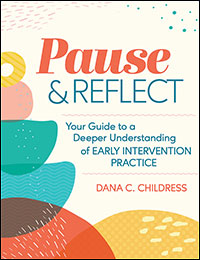When you’re preparing for a home visit with a family, what are some things you can do to get things off on the right foot and lay the groundwork for a productive partnership? Today’s post presents 5 key actions and attitudes that every early intervention professional should focus on at the beginning of each home visit. Excerpted and lightly adapted from Pause and Reflect by Dana C. Childress, this list can be a helpful guide to you as you get ready to conduct positive and effective visits with young children and their families.
Enter mindfully. Before you greet a family, take a moment to set your intention. Enter your visit mindfully, with the goal and mission of early intervention in mind. Quickly do a mental scan to review the things you did to prepare for this specific visit. Make sure your phone is set to vibrate or mute so you can be fully present with the family. Now you’re ready to knock on the door!
Take responsibility for the energy you bring to the family. While setting your intention for the visit, start by taking a deep, cleansing breath and reminding yourself to leave behind whatever stresses or frustrations you had before the visit. Enter the environment in a frame of mind that will allow you to focus on what this child and family need. This can be easier said than done on hectic days with cancellations or personal distractions. Just keep in mind that you would want a service provider for yourself or your child who is present and focused, not hurried or distracted. Resolve to be that person for each family.
Enter the environment in a frame of mind that will allow you to focus on what this child and family need.
Acknowledge each member of the family. As you enter the home environment, make sure you greet each person you see. Say hi to the caregiver, acknowledge all the children, and introduce yourself to any other family members or friends. You can just shake hands and say your name if you’re worried about confidentiality. If you work to create an atmosphere of genuine friendliness and respect, you’ll be more likely to receive that in return.
Follow the caregiver’s lead. If you’re visiting the family’s home, you are a guest. Scan the environment and follow the caregiver’s lead. For instance, if you notice that there are shoes piled by the front door and the family members are in bare feet, ask if you should remove your shoes. If you notice that the caregiver always takes you to a certain room, let them know that you can join them wherever they were before you arrived, or wherever they are most comfortable. Following the caregiver’s lead means keeping and join whatever is happening.
Following the caregiver’s lead means keeping an open mind and a flexible presence to go where you’re needed...
Check in about the family’s life. Take a few moments to ask about how the caregiver and family are. If this isn’t your first visit with the family, you may be tempted to jump straight to reviewing the joint plan you developed together, but acknowledging the caregiver as a fellow human first can break down walls and build rapport. (This is especially important with a new family or a caregiver who is reluctant to engage.) If the caregiver shared a personal challenge during your last visit, check in about that, but be careful to maintain professional boundaries. Being friendly without being friends is important, because becoming friends with a family could compromise your objectivity and make it harder for the family to address concerns with or about you to the service coordinator. Check in, show you remember what’s important to the caregiver, and show you care, but always be mindful of boundaries as you do.
Set the stage for what’s to come. As you transition from greeting to intervention, use the joint plan to ground you. If this isn’t your first visit, you might want to revisit the previous visit’s joint plan with a specific question that highlights the strategy the caregiver was planning to implement, such as “How did it go with using music to help Amber settle down at naptime?” Be sure your question is open-ended; avoid asking a simple yes/no question or using jargon that the caregiver might find confusing or alienating.
Pay attention to where you sit or stand, and take care to position yourself so you can best support the caregiver’s learning. For example, rather than plopping down in front of the toddler and reaching for a toy, try sitting beside the caregiver and asking what she and the child have been up to that day. Or sit so that you’re one “point” in the intervention triangle, establishing the triad that includes you, the caregiver, and the child. Another option is to start by sitting next to the caregiver and letting him guide where you go next. If the caregiver is on the couch, start there. If the caregiver is at the kitchen table, check in there and then transition to a discussion about what he wants to do during today’s visit. This strategy will help caregivers understand that you are not just there for the child; you are there as a support and partner to them, too.
Greetings and check-ins are vitally important to the success of every home visit, but they’re just the first part of the seven-step home visiting process Dana Childress lays out in Pause and Reflect. For a complete, practical guide to this process, check out the book behind today’s post.
Pay attention to where you sit or stand, and take care to position yourself so you can best support the caregiver’s learning.

GET THE BOOK
Pause and Reflect
Your Guide to a Deeper Understanding of Early Intervention Practice
By Dana C. Childress, Ph.D.
“I honestly couldn’t put the book down…a must read for new and practicing early interventionists.”—Linda Labas, M.Ed., University of Maine
“A practical, easy-to-read guide for how to partner with caregivers in early intervention to promote child learning as part of everyday activities.”—Dathan Rush, Ed.D., Director, Family, Infant, & Preschool Program, Morganton, NC
“Includes a variety of interactive activities, anecdotes, checklists, examples, and resources for both individual and group study, making it a wonderful addition to the libraries of both EI and professional development providers.”—Juliann Woods, Florida State University
Stay up to date on the latest posts, news, strategies, and more!
Sign up for one of our FREE newslettersMore posts like this

Promoting Developmentally Supportive Parenting: 3 Key Components to Focus on with Families
May 12, 2020
25 Questions Early Childhood Professionals Should Ask Families
May 4, 2021


Write a Comment
Your email address will not be published. Required fields are marked *
Post a Comment